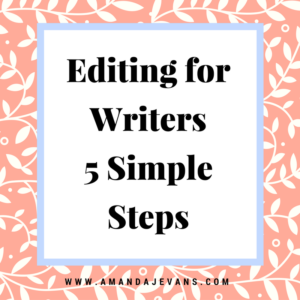On the 18th of September, 2016, I finished writing my novella. Actually, it’s probably better to say that it is a novelette coming in at just under 20,000 words. Today I wanted to talk about editing for writers and the process I used.
Editing for Writers – My Step by Step Process
Step 1: Type The Content
The first step for me was to actually type up my manuscript. My first draft was handwritten in two A5 notebooks and so I spent two days typing everything in Word. I was so excited typing up my story and there were little fixes and small bits of editing that took place during this process. My excitement dissipated however when I realised after spending two days of typing that my final word count was so low. Now don’t get me wrong, while I was disappointed with the final word count, I was proud of my accomplishment. This is my first full-length fiction piece. It is something that has been on my goals list for quite a number of years now, and actually completing it was huge. The disappointment came from looking at all the pages in my notebooks and realising that they didn’t contain as much as I had anticipated. I had my heart set on a novel, but once typed into the computer, my novel became a novelette.
Step 2: Leave it Aside
Step 2 might be hard for some, but it really is worth doing. I left my manuscript untouched for two months before looking at it again. During that time I started work on my second novel. I needed to remove myself from the writing and the characters so when the time for editing came, I could look at it with fresh eyes.
When I went back to it I was really surprised. Before I started reading it, I ran my Grammarly app. I use the free version of this software program and it picks up grammatical errors such as commas and spelling mistakes. After correcting all of these, I sat down and began my reading. I wasn’t looking for anything in particular. I just wanted to read the manuscript and see if anything stood out. I corrected a few things in my first read through and I remember smiling as I reached the end.
Step 3: Description
On my second read through I was looking at the description. Where it was missing, where it might have contradicted itself, and if I had enough to show the scene in my mind to the reader. As the writer, I see the images in my head, like watching a movie, and I wanted to make sure that I was getting this information across to my readers. Could they see the characters? Did I describe the room? Did I describe the outdoor scenes correctly?
Step 4: Passive Voice/Tense
This step was the hardest and I know I will be relying on my editor to pick up on much of this. On my final read through I looked for passive voice and whether my tenses remained the same throughout. My novelette is written in past tense so I had to make sure this followed throughout.
Editing for Writers – Handing Over to My Editor
After completing all the editing for writers steps listed above I was now ready to pass my first draft over to my editor. This is where the hard work will being. I know that she will look at everything and come back to me with the things I missed and recommended changes which I will have to go through one by one. This is a vital step in the process and having an editor you trust and respect are paramount. My editor is a good friend and writing colleague and I trust her input. I know that she will see things that I haven’t and she will read from the prospective of a reader. I am the author and the creator of the story which means I tend to miss a lot. I know the characters, I know their quirks, their personalities, and what makes them tick. What my editor will tell me is whether or not all this information is shared with the reader. If they can relate to the characters, if the story flows, if the plot is believable and realistic, and if I have managed to portray the emotion that I know is there.
There is still quite a way to go yet, but for me, this is a massive achievement and I can’t wait to see how things go.
Editing for writers isn’t easy. In fact, it is probably the hardest part. There is so much that we can miss as the creator of the story and that is why I highly recommend getting an editor and some beta readers before you publish your work.
Until next time,
Keep writing
Amanda J Evans is an award-winning Irish author and writing coach. Amanda writes adult romance that often crosses into paranormal and fantasy. Growing up with heroes like Luke Skywalker and Indiana Jones, her stories centre on good versus evil with a splice of love and magic thrown in too. Her books have all won awards and her novella, Hear Me Cry, won the Book of the Year Award at the Dublin Writers Conference 2018. Amanda is also the author of Surviving Suicide: A Memoir from Those Death Left Behind, published in 2012.

